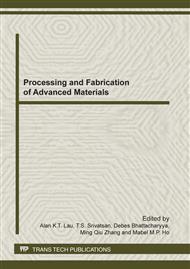p.279
p.283
p.287
p.291
p.298
p.305
p.309
p.313
p.317
Welding Heat Transfer Analysis Using Element Free Galerkin Method
Abstract:
Mesh-less methods belong to a new class of numerical methods in computational mechanics and offer several advantages over the conventional mesh-based methods. They enable modelling of processes involving high deformation, severe discontinuities (e.g. fracture) and multiple physical processes. These types of situations are usually encountered in arc welding, rendering its modelling suitable via mesh-less methods. In this paper, a mesh-less Element Free Galerkin (EFG) method has been developed to model the heat transfer during welding. The results predicted by the EFG method are found to be in close agreement with those obtained by the finite element method and those observed in welding experiments. This demonstrates the effectiveness and utilities of the EFG method for modelling and understanding the heat transfer processes in arc welding.
Info:
Periodical:
Pages:
298-301
Citation:
Online since:
November 2011
Authors:
Price:
Сopyright:
© 2012 Trans Tech Publications Ltd. All Rights Reserved
Share:
Citation:


